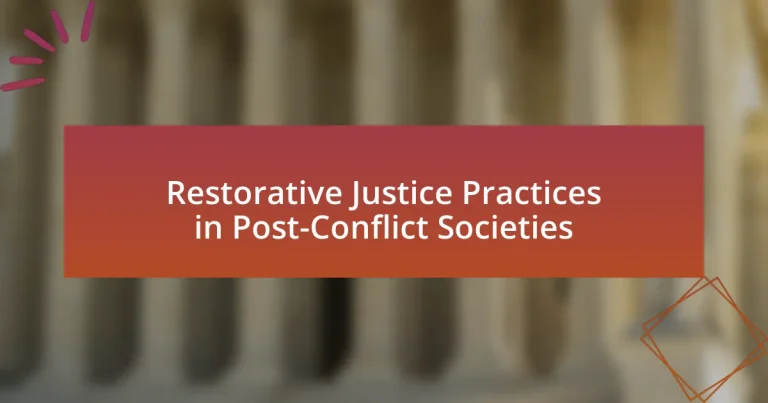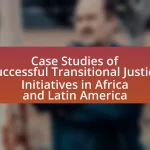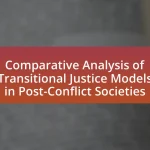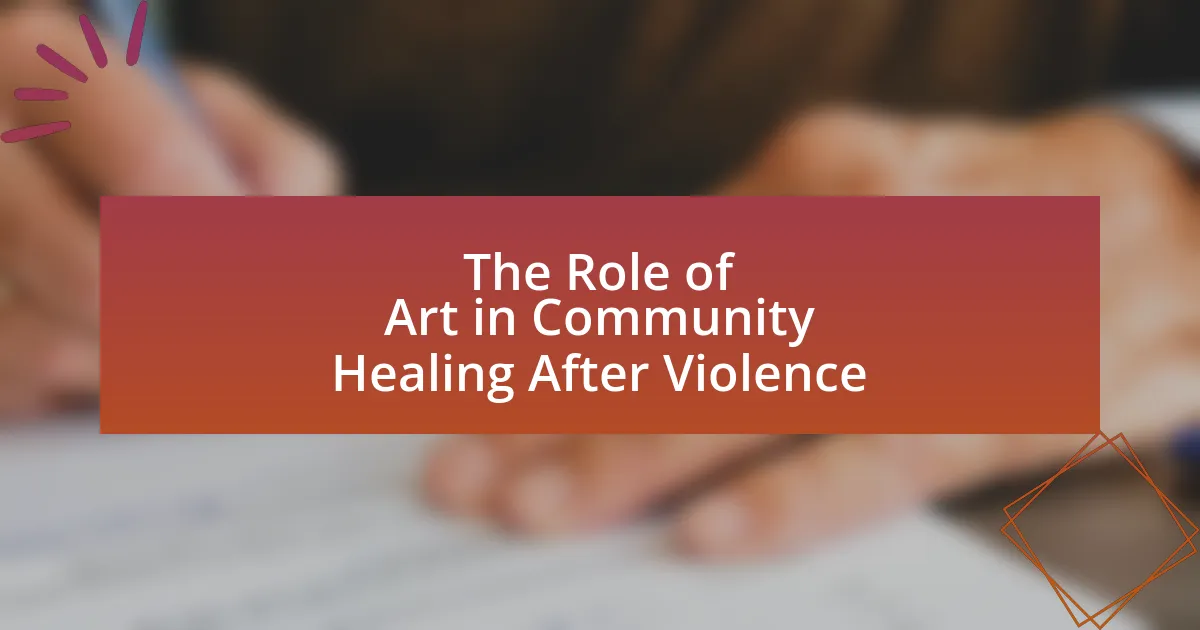Restorative justice practices in post-conflict societies focus on repairing harm through inclusive dialogue and reconciliation, involving victims, offenders, and community members. These practices, such as truth commissions and community-based reparations, prioritize healing and accountability over punishment, leading to improved community cohesion and reduced recidivism. Key principles include accountability, healing, and community involvement, which are essential for fostering trust and rebuilding relationships. Despite facing challenges like mistrust and cultural resistance, effective implementation can enhance individual and community outcomes, promoting long-term social restoration and resilience.
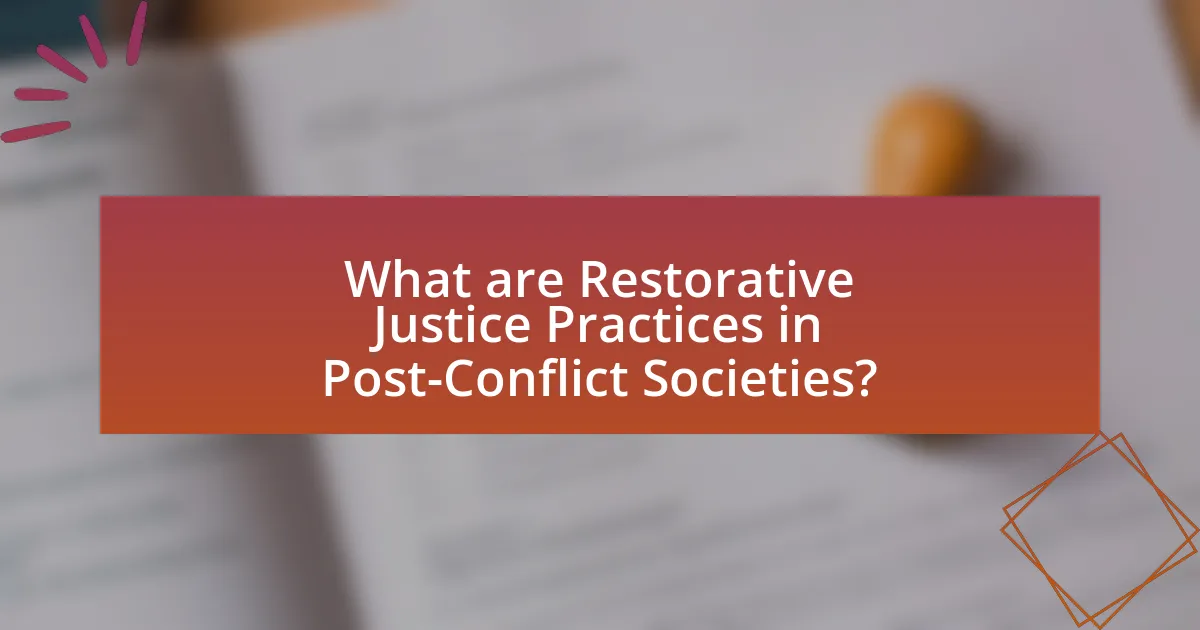
What are Restorative Justice Practices in Post-Conflict Societies?
Restorative justice practices in post-conflict societies are approaches aimed at repairing harm caused by conflict through inclusive dialogue and reconciliation processes. These practices often involve victims, offenders, and community members in discussions that seek to address the underlying issues of conflict, promote healing, and restore relationships. For instance, truth commissions, community-based reparations, and restorative circles are commonly utilized to facilitate understanding and accountability, allowing communities to move forward collectively. Evidence from various post-conflict settings, such as South Africa’s Truth and Reconciliation Commission, demonstrates that these practices can lead to reduced recidivism and improved community cohesion by fostering a sense of justice that emphasizes restoration rather than punishment.
How do Restorative Justice Practices differ from traditional justice systems?
Restorative Justice Practices differ from traditional justice systems primarily in their focus on repairing harm rather than punishing offenders. Traditional justice systems emphasize retribution and punishment, often sidelining the needs of victims and the community, while restorative justice prioritizes dialogue, accountability, and healing for all parties involved. For instance, restorative justice practices involve facilitated meetings between victims and offenders, allowing victims to express their feelings and needs, which contrasts sharply with the adversarial nature of traditional courts where the focus is on legal guilt or innocence. Research indicates that restorative justice can lead to higher victim satisfaction and lower recidivism rates, demonstrating its effectiveness in addressing the root causes of crime and fostering community restoration.
What principles underpin Restorative Justice Practices?
Restorative Justice Practices are underpinned by several key principles, including accountability, healing, and community involvement. Accountability emphasizes that offenders must take responsibility for their actions and understand the impact of their behavior on victims and the community. Healing focuses on addressing the emotional and psychological needs of both victims and offenders, facilitating a process that promotes reconciliation. Community involvement encourages the participation of community members in the justice process, fostering a collective approach to resolving conflicts and restoring relationships. These principles are supported by various studies, such as those conducted by the International Institute for Restorative Practices, which highlight the effectiveness of restorative approaches in reducing recidivism and enhancing victim satisfaction.
How do these practices promote healing in post-conflict contexts?
Restorative justice practices promote healing in post-conflict contexts by fostering dialogue, accountability, and community involvement. These practices encourage victims and offenders to engage in conversations that address the harm caused, allowing victims to express their feelings and needs while offenders take responsibility for their actions. Research indicates that such engagement can lead to emotional healing for victims, as they feel heard and validated, while offenders often experience remorse and a desire to make amends. For example, a study by the United Nations Development Programme found that restorative justice initiatives in post-conflict societies significantly reduced recidivism rates and improved community cohesion, demonstrating their effectiveness in promoting healing and reconciliation.
Why are Restorative Justice Practices important in post-conflict societies?
Restorative Justice Practices are important in post-conflict societies because they facilitate healing and reconciliation among individuals and communities affected by violence. These practices promote dialogue between victims and offenders, allowing for acknowledgment of harm and fostering understanding, which is essential for rebuilding trust. Research indicates that restorative justice can lead to lower recidivism rates and higher victim satisfaction compared to traditional punitive measures, as seen in studies conducted in countries like South Africa and Rwanda, where restorative approaches have been integral to national healing processes following conflict.
What role do these practices play in reconciliation processes?
Restorative justice practices play a crucial role in reconciliation processes by fostering dialogue, accountability, and healing among affected communities. These practices facilitate open communication between victims and offenders, allowing for the acknowledgment of harm and the expression of emotions, which is essential for rebuilding trust. For instance, in post-apartheid South Africa, the Truth and Reconciliation Commission utilized restorative justice principles to address past injustices, enabling victims to share their experiences and offenders to take responsibility, thereby promoting societal healing and unity. This approach not only addresses individual grievances but also contributes to broader social cohesion by encouraging collective understanding and forgiveness.
How do they contribute to community rebuilding?
Restorative justice practices contribute to community rebuilding by fostering dialogue and reconciliation among affected individuals and groups. These practices facilitate healing by allowing victims to share their experiences and grievances, while also providing offenders an opportunity to take responsibility for their actions. Research indicates that communities engaged in restorative justice initiatives experience lower recidivism rates and improved social cohesion, as evidenced by a study published in the “Journal of Conflict Resolution,” which found that restorative justice programs led to a 30% reduction in repeat offenses in post-conflict settings. This approach not only addresses the immediate harm caused by conflict but also promotes long-term community resilience and unity.
What challenges do Restorative Justice Practices face in post-conflict societies?
Restorative Justice Practices face significant challenges in post-conflict societies, primarily due to deep-seated mistrust among communities. This mistrust often stems from historical grievances and trauma, making it difficult for victims and offenders to engage in dialogue. Additionally, the lack of institutional support and resources can hinder the implementation of restorative processes, as seen in countries like Rwanda, where the aftermath of genocide left a fragmented social fabric. Furthermore, cultural differences in understanding justice can complicate the acceptance of restorative approaches, as traditional punitive systems may dominate. These factors collectively impede the effectiveness and sustainability of restorative justice initiatives in such contexts.
What are the common obstacles to implementing these practices?
Common obstacles to implementing restorative justice practices in post-conflict societies include lack of political will, insufficient resources, and cultural resistance. Political will is often hindered by ongoing power struggles and a reluctance to address past injustices, as seen in countries like Rwanda, where the government initially prioritized stability over justice. Insufficient resources, including funding and trained personnel, impede the establishment of effective restorative justice programs, as evidenced by the limited success of such initiatives in regions with constrained budgets. Cultural resistance arises from traditional views on justice that favor punitive measures over restorative approaches, which can be observed in various societies where retributive justice is deeply ingrained.
How can these challenges be addressed effectively?
Restorative justice challenges in post-conflict societies can be effectively addressed through community engagement, inclusive dialogue, and the establishment of supportive legal frameworks. Community engagement fosters trust and participation, allowing victims and offenders to share their experiences and perspectives, which is essential for healing. Inclusive dialogue ensures that all voices, particularly marginalized groups, are heard, promoting a sense of ownership in the restorative process. Furthermore, supportive legal frameworks provide the necessary structure and legitimacy for restorative practices, ensuring they align with national and international human rights standards. Evidence from various post-conflict societies, such as South Africa’s Truth and Reconciliation Commission, demonstrates that these approaches can lead to successful reconciliation and social cohesion.
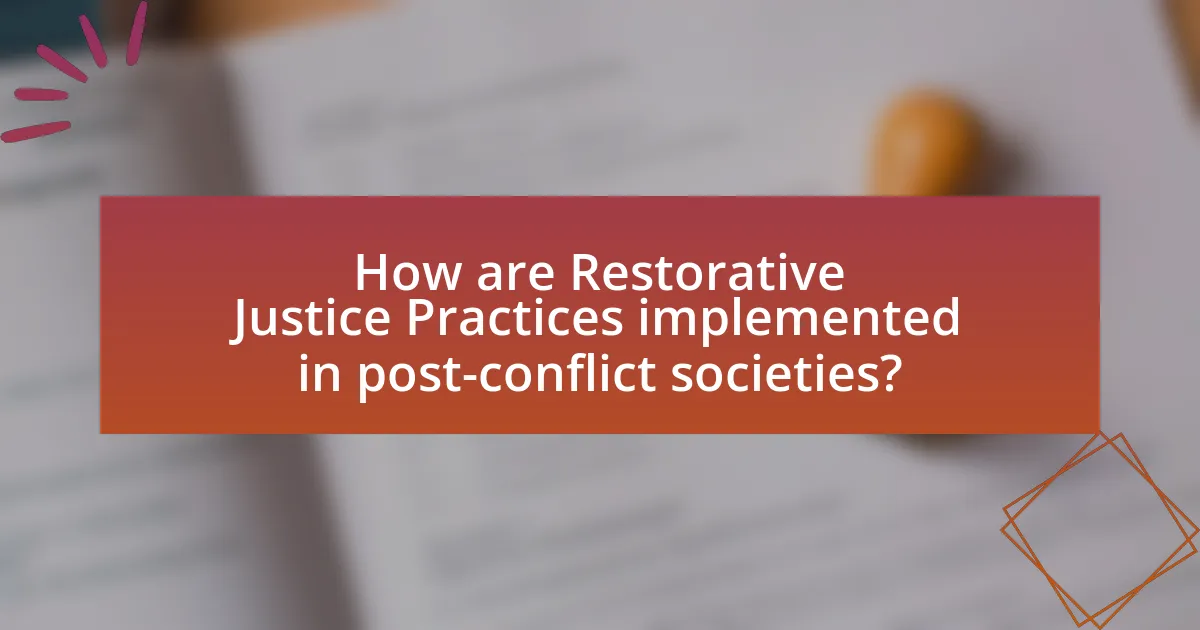
How are Restorative Justice Practices implemented in post-conflict societies?
Restorative justice practices in post-conflict societies are implemented through community-based dialogues, truth commissions, and reparative measures that focus on healing rather than punishment. These practices aim to restore relationships and address the needs of victims, offenders, and the community. For instance, in South Africa, the Truth and Reconciliation Commission facilitated discussions between victims and perpetrators, allowing for acknowledgment of harm and fostering societal healing. Additionally, in Rwanda, community-based Gacaca courts were established to address genocide-related crimes, emphasizing collective accountability and reconciliation. These implementations demonstrate a shift from retributive justice to restorative approaches, promoting social cohesion and rebuilding trust in fractured communities.
What are the key steps in the implementation process?
The key steps in the implementation process of restorative justice practices in post-conflict societies include assessment, stakeholder engagement, program design, training, pilot testing, evaluation, and scaling.
Assessment involves analyzing the specific needs and context of the post-conflict society to identify the most effective restorative justice approaches. Stakeholder engagement ensures that all relevant parties, including victims, offenders, and community members, are involved in the process, fostering a sense of ownership and collaboration. Program design focuses on creating tailored restorative justice programs that address the unique circumstances of the community.
Training is essential for facilitators and community members to effectively implement restorative practices, ensuring they understand the principles and techniques involved. Pilot testing allows for the trial of the program on a small scale, providing insights and opportunities for adjustments before broader implementation. Evaluation measures the effectiveness of the restorative justice practices, using feedback to refine and improve the approach. Finally, scaling involves expanding successful programs to reach a wider audience, ensuring sustainability and long-term impact in the post-conflict society.
How do stakeholders engage in the implementation of these practices?
Stakeholders engage in the implementation of restorative justice practices in post-conflict societies through collaboration, resource allocation, and community involvement. Local governments, NGOs, and community leaders work together to create frameworks that support restorative initiatives, ensuring that they are culturally relevant and effective. For example, in Rwanda, the Gacaca courts involved community members in the justice process, allowing them to participate in hearings and contribute to reconciliation efforts, which facilitated healing and social cohesion after the genocide. This collaborative approach not only empowers stakeholders but also enhances the legitimacy and acceptance of restorative practices within the community.
What role does community involvement play in successful implementation?
Community involvement is crucial for the successful implementation of restorative justice practices in post-conflict societies. Engaging local communities fosters trust, enhances participation, and ensures that the justice process is culturally relevant and accepted. Research indicates that when communities actively participate, the likelihood of successful outcomes increases, as seen in the case of South Africa’s Truth and Reconciliation Commission, where community engagement was pivotal in addressing grievances and promoting healing. This involvement not only empowers individuals but also strengthens social cohesion, making the restorative justice process more effective and sustainable.
What models of Restorative Justice are used in post-conflict settings?
In post-conflict settings, the models of Restorative Justice primarily include victim-offender mediation, community conferencing, and truth commissions. Victim-offender mediation facilitates direct dialogue between victims and offenders, allowing for personal accountability and healing. Community conferencing involves broader community participation, where stakeholders collectively address the harm caused and develop a plan for restitution. Truth commissions, such as those in South Africa, aim to uncover the truth about past atrocities, promote reconciliation, and provide a platform for victims to share their experiences. These models have been implemented in various post-conflict societies to foster healing and restore social harmony.
How do different models adapt to various cultural contexts?
Different models of restorative justice adapt to various cultural contexts by incorporating local customs, values, and social structures into their frameworks. For instance, in Indigenous communities, restorative practices often align with traditional conflict resolution methods that emphasize community involvement and healing rather than punitive measures. Research by Zehr (2002) highlights that these adaptations enhance the relevance and effectiveness of restorative justice by fostering community ownership and participation. Additionally, models may adjust their processes to accommodate cultural norms regarding authority and communication styles, ensuring that they resonate with the specific societal dynamics of the post-conflict environment. This contextualization is crucial for achieving meaningful reconciliation and restoring social harmony.
What are the outcomes of these models in practice?
Restorative justice models in post-conflict societies lead to improved community cohesion and reduced recidivism rates. These models facilitate dialogue between victims and offenders, fostering understanding and healing, which can result in lower rates of reoffending. For instance, a study by the United Nations Development Programme in 2016 found that restorative justice initiatives in Rwanda contributed to a 30% decrease in repeat offenses among participants compared to traditional punitive measures. Additionally, restorative practices often enhance victim satisfaction and promote social reintegration of offenders, further strengthening community ties.
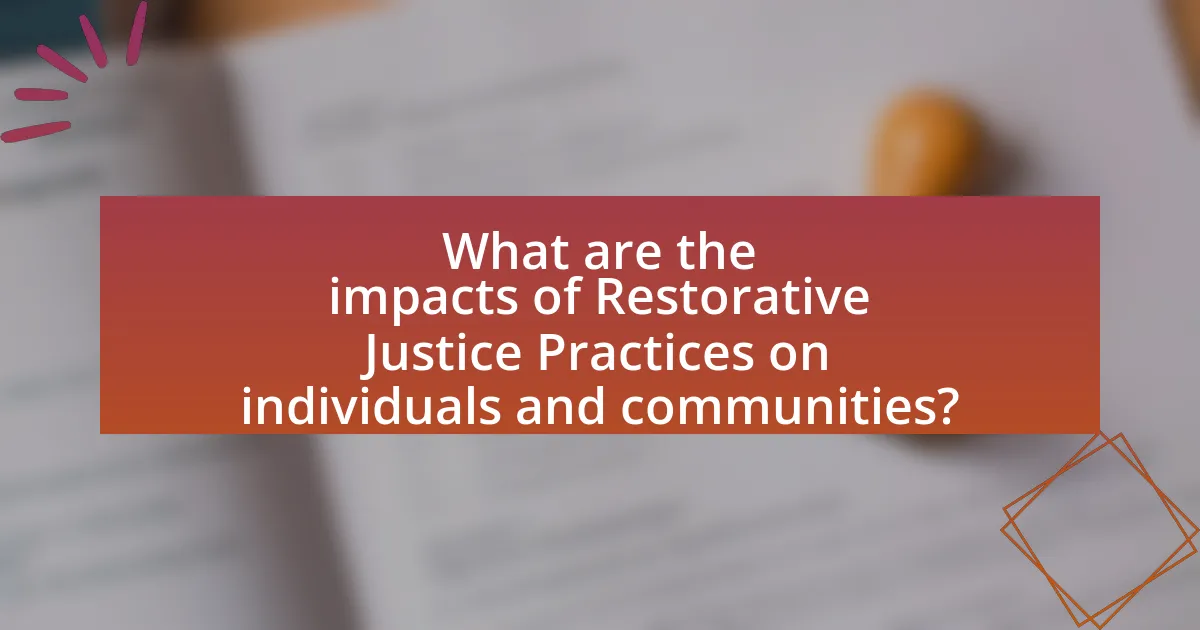
What are the impacts of Restorative Justice Practices on individuals and communities?
Restorative Justice Practices significantly enhance individual healing and community cohesion. These practices facilitate dialogue between victims and offenders, promoting accountability and empathy, which can lead to reduced recidivism rates. Research indicates that communities implementing restorative justice experience lower crime rates and improved social relationships. For instance, a study by the University of Minnesota found that restorative justice programs led to a 30% decrease in repeat offenses among participants. Additionally, victims often report higher satisfaction levels and a sense of closure, contributing to overall community resilience and trust.
How do these practices affect victims of conflict?
Restorative justice practices significantly impact victims of conflict by promoting healing and reconciliation. These practices provide victims with a platform to share their experiences, which can lead to emotional relief and a sense of empowerment. Research indicates that victims who participate in restorative justice processes report higher levels of satisfaction with the justice system compared to traditional punitive measures. For instance, a study published in the “Journal of Conflict Resolution” by John Braithwaite highlights that victims often feel a greater sense of closure and validation when they engage in dialogues with offenders. This engagement can foster a sense of community and contribute to the rebuilding of trust in post-conflict societies.
What psychological benefits do victims experience through participation?
Victims experience several psychological benefits through participation in restorative justice practices, including empowerment, emotional healing, and a sense of closure. Empowerment occurs as victims actively engage in the justice process, allowing them to voice their experiences and contribute to the resolution, which can enhance their sense of control over their circumstances. Emotional healing is facilitated through dialogue with offenders, enabling victims to express their feelings and receive acknowledgment of their suffering, which can lead to reduced feelings of anger and resentment. A sense of closure is often achieved when victims see offenders take responsibility for their actions, fostering a pathway toward forgiveness and moving forward. Research indicates that these benefits can significantly improve victims’ mental health outcomes, as evidenced by studies showing lower levels of post-traumatic stress symptoms among those who participate in restorative justice compared to those who do not.
How do victims perceive justice through Restorative Justice Practices?
Victims perceive justice through Restorative Justice Practices as a process that emphasizes healing, accountability, and dialogue rather than punishment. This approach allows victims to express their feelings, receive acknowledgment of their suffering, and engage directly with offenders, which can lead to a sense of closure and empowerment. Research indicates that victims often report higher satisfaction with restorative processes compared to traditional justice systems, as they feel more involved and valued in the resolution of their cases. For instance, a study by the United Nations Office on Drugs and Crime found that victims participating in restorative justice programs experienced significant improvements in emotional well-being and a greater sense of justice compared to those who went through conventional legal proceedings.
What are the effects on offenders in post-conflict societies?
Offenders in post-conflict societies often experience significant psychological, social, and legal effects. These individuals may face stigma and isolation from their communities, which can hinder reintegration efforts. Research indicates that offenders may also struggle with mental health issues, such as PTSD, due to their involvement in conflict-related violence. Additionally, the legal frameworks in post-conflict settings can vary, leading to inconsistent accountability measures and potential impunity for offenders. For instance, transitional justice mechanisms, such as truth commissions, may offer opportunities for offenders to acknowledge their actions, but they can also create tensions within communities seeking justice. Overall, the effects on offenders are complex and deeply intertwined with the broader societal context of healing and reconciliation.
How do Restorative Justice Practices influence offender rehabilitation?
Restorative Justice Practices significantly enhance offender rehabilitation by promoting accountability, empathy, and community involvement. These practices facilitate direct dialogue between offenders and victims, allowing offenders to understand the impact of their actions, which fosters a sense of responsibility. Research indicates that programs incorporating restorative justice elements, such as victim-offender mediation, lead to lower recidivism rates; for instance, a meta-analysis by the Campbell Collaboration found that restorative justice interventions reduce reoffending by approximately 14% compared to traditional punitive measures. This approach not only aids in the emotional healing of victims but also encourages offenders to reintegrate positively into society, thereby contributing to overall community restoration.
What are the long-term impacts on offenders’ reintegration into society?
Long-term impacts on offenders’ reintegration into society include increased recidivism rates, social stigma, and challenges in securing employment and housing. Research indicates that approximately 67% of released prisoners are rearrested within three years, highlighting the difficulty of successful reintegration. Additionally, societal perceptions often label former offenders as untrustworthy, which can hinder their ability to form supportive relationships and access community resources. Employment barriers are significant, as studies show that individuals with criminal records face a 50% lower chance of being hired compared to those without. These factors collectively contribute to a cycle of reoffending and social exclusion, complicating the reintegration process for offenders.
What best practices can enhance the effectiveness of Restorative Justice Practices?
Best practices that can enhance the effectiveness of Restorative Justice Practices include fostering community involvement, ensuring voluntary participation, and providing adequate training for facilitators. Community involvement creates a supportive environment that encourages dialogue and healing, as evidenced by the success of community-based programs in various post-conflict societies. Voluntary participation ensures that all parties are genuinely engaged, which increases the likelihood of meaningful resolutions, as shown in studies where consent led to higher satisfaction rates among participants. Additionally, training facilitators in conflict resolution and cultural sensitivity equips them to handle diverse situations effectively, as demonstrated by programs that have reported improved outcomes when facilitators are well-prepared.
How can training and education improve outcomes in these practices?
Training and education can significantly improve outcomes in restorative justice practices in post-conflict societies by equipping practitioners with essential skills and knowledge. Enhanced training programs foster a deeper understanding of conflict resolution, empathy, and community engagement, which are crucial for effective restorative justice implementation. Research indicates that trained facilitators can better navigate complex emotional dynamics and cultural sensitivities, leading to more successful mediation outcomes. For instance, a study by the United Nations Development Programme found that communities with trained restorative justice practitioners reported a 30% increase in successful conflict resolutions compared to those without such training. This evidence underscores the importance of structured educational initiatives in promoting effective restorative justice practices.
What role does ongoing community support play in sustaining these practices?
Ongoing community support is crucial for sustaining restorative justice practices in post-conflict societies. This support fosters trust and collaboration among community members, which are essential for the successful implementation of restorative initiatives. Research indicates that communities actively engaged in restorative processes experience higher rates of participation and commitment, leading to more effective conflict resolution and healing. For instance, a study by Zehr and Gohar (2003) highlights that community involvement enhances accountability and encourages shared responsibility, thereby reinforcing the sustainability of restorative practices.
